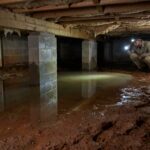Top Strategies for Effective Foundation Repair: Ensuring Your Home’s Stability
When it comes to your home, the foundation is kind of like that quiet friend who always seems unassuming but is secretly holding everything together. Without a solid foundation, things can start to unravel quite literally — cracks in walls, uneven floors, and doors that suddenly become more temperamental than a cat at bath time. So, how do we ensure our homes stand strong against the tests of time? Let’s dive into some effective strategies for foundation repair that will keep your domicile standing tall and proud.
Understanding Foundation Issues
Before jumping into repair strategies, let’s make sure we know what we’re dealing with. Foundations can experience various problems, including:
1. **Settling:** This happens when the ground beneath your foundation shifts due to moisture changes, leading to cracks.
2. **Heaving:** The opposite of settling, heaving occurs when soil expands (often due to moisture) and pushes the foundation upwards.
3. **Water Damage:** Poor drainage systems can lead to excess moisture around the foundation, causing erosion and damage.
4. **Pest Infestation:** Termites and other pests can weaken foundational structures significantly.
Understanding these issues is crucial for developing effective repair strategies.
Implement a Drainage System
The number one enemy of any foundation is water. Just as we don’t want our basement to turn into a swimming pool, we also don’t want our foundation soaking up too much moisture. Here are some strategies to manage drainage effectively:
– **Gutters and Downspouts:** Ensure your gutters are clean and downspouts direct water at least six feet away from your foundation. Think of them as the bouncers at the club, keeping unwanted guests (water) away from the main entrance (your foundation).
– **French Drains:** These perforated pipes collect water from around your foundation and channel it away. Installing a French drain might sound fancy, but consider it the equivalent of giving your foundation a cozy umbrella to protect it from the rain.
– **Sump Pumps:** If your property is prone to flooding, a sump pump can be your best friend. It sits in a sump basin and pumps water out, keeping your basement dry and happy.
Regular Maintenance Checks
Just like your car needs regular oil changes, your foundation requires maintenance checks. Here are some essential steps for keeping an eye on your home’s foundation health:
– **Inspections:** Conduct regular visual inspections of your foundation, both inside and outside. Look for cracks, leaks, or signs of moisture. You might not find a hidden treasure, but you could prevent a costly surprise!
– **Monitor Gaps:** Pay attention to gaps between windows and doors. If they seem to be increasing, it might indicate underlying foundation issues. You wouldn’t ignore a growling stomach, so don’t ignore growing gaps!
– **Soil Moisture Levels:** Regularly check the moisture levels of the soil around your foundation, especially during changing seasons. Drastic shifts can lead to settlement issues.
Foundation Repair Methods
Now that we’ve armed ourselves with knowledge and preventive measures, it’s time to delve into various foundation repair methods. Each method has its pros and cons, so weigh them carefully before deciding.
1. **Piering Systems:** This method involves installing piers beneath the foundation to lift and stabilize it. There are different types, such as steel push piers, helical piers, and concrete piers. Each serves a purpose, much like different teams in a superhero movie — each with its unique powers.
2. **Slab Jacking:** If you have a concrete slab foundation that’s sinking, slab jacking is your go-to solution. This technique injects a special mix underneath the slab to lift it back to its original position. Think of it as a foundation facelift — instant lift without the need for invasive surgery!
3. **Wall Anchors:** For bowing or leaning walls in basements, wall anchors come to the rescue. They consist of steel plates and rods to provide structural support. It’s like giving your walls a supportive hug when they’re feeling down.
4. **Foam Injection:** This modern and less intrusive method involves injecting polyurethane foam beneath the foundation to fill voids and raise settled areas. Not only is it effective, but it’s also a bit like blowing up a balloon — quick, easy, and possibly messy if you’re not careful!
Choosing the Right Professionals
Once you’ve decided on a repair method, it’s critical to choose the right professionals for the job. After all, you wouldn’t let just anyone repair your car – the same applies to your home. Here’s how to ensure you’re picking the right expert:
– **Research Credentials:** Look for contractors with licenses, insurance, and experience specifically in foundation repair. Think of it as checking the credentials of a doctor; you want someone who knows their stuff.
– **Read Reviews:** Online platforms can provide insights into the experiences of previous clients. Check for testimonials that highlight quality workmanship and customer service. A little research can save you from choosing a contractor who is more interested in going to the bank than fixing your foundation.
– **Get Estimates:** Obtain several estimates from different contractors. Compare not just prices but also the scope of work included. Remember, the cheapest option isn’t always the best – you wouldn’t buy a budget car if you wanted to road trip across the country!
– **Ask Questions:** Don’t hesitate to ask potential contractors about their methods and why they prefer certain techniques. A reputable contractor will appreciate your diligence and gladly provide answers.
Preventive Measures Post-Repair
Congratulations! You’ve successfully repaired your foundation. But the journey doesn’t end here. To ensure your hard work pays off, consider implementing these preventive measures:
– **Landscape Wisely:** While flowers and shrubs can beautify your yard, make sure they’re not causing havoc on your foundation. Avoid planting large trees too close to your home, as their roots can undermine your foundation.
– **Water Your Lawn Wisely:** During dry spells, be mindful of how much water you’re applying to your lawn. Too much watering can add pressure to your foundation, while too little can lead to shrinkage and settling.
– **Keep Soil Even:** Maintain an even grading away from your foundation to prevent water pooling. Think of it as a gentle slope — your foundation prefers a smooth ride.
– **Install Vapor Barriers:** If you have a crawlspace, consider installing vapor barriers to keep moisture at bay. This can help prevent mold growth and wood rot that could affect your foundation’s stability.
Conclusion
Your home’s foundation might not be the most glamorous topic at a dinner party, but ensuring its stability is essential for protecting your investment. By understanding foundation issues, implementing drainage solutions, performing regular maintenance checks, choosing the right repair strategies, and enlisting skilled professionals, you can ensure your home remains a pillar of strength for years to come.
Remember, a sturdy foundation is more than just bricks and concrete; it’s the bedrock of your home sweet home. So, take these strategies to heart, and keep that foundation as strong as your favorite story about the time you almost took a tumble on a wobbly floor!


